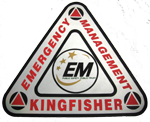 |
|||
Lightning Safety
Lightning Safety - Printable Version
(Requires Adobe Reader. Get Adobe Reader here.)
Lightning Safety in Oklahoma
Every year people are killed or injured by
lightning strikes in Oklahoma. On average, about 50 bolts of lightning will strike less than a mile from any given person each year in Oklahoma - about 1 million strikes per year across the state.
Where you are when these strikes occur could greatly affect your chances of getting struck by lightning.
If you frequently work or play outdoors, your risk is significantly increased. Use your best judgment to remain safe during storms and remember the following tips:
When Outside:
If you hear thunder, lightning is close enough to strike. Go inside or get into a hard-topped vehicle.
If Caught Outside:
- Do not lie flat on the ground
- Crouch with your feet together
- Do not seek shelter under trees
When Inside:
- Stay away from windows
- Don’t use the phone
- Stay away from electric appliances
- Stay away from water
- Unplug appliances to protect them
When Boating:
A boat is usually the highest object in its area, making boats especially vulnerable to lighting strikes. Get to shore and into a
building if possible.
If Caught on the Water:
- Lower fishing poles and other tall objects
- Try to stay in a dry spot on the boat
- Do not touch electrical or metal objects
Common Lightning Myths:
Myth: If it’s not raining then there is no danger from lightning.
Truth: Lightning often strikes outside of heavy rain and may occur more than ten miles away from any rainfall.
Myth: Rubber soles on shoes or rubber tires will protect you from being struck by lightning.
Truth: Rubber soles on shoes and rubber tires offer no protection from lightning. However, the metal body of a hardtopped vehicle does provide increased protection. Make sure not to touch any metal inside the vehicle.
Myth: People struck by lightning carry an electrical charge – never touch anyone who has just been struck by lightning.
Truth: People just struck by lightning carry no electrical charge and should be given attention, including CPR, immediately.
Plan Ahead for Lightning
The best way to protect yourself is to plan ahead so you’re not in a dangerous location when storms threaten.
- Be prepared to end golf games or fishing trips early when lightning approaches. The inconvenience of rescheduling outdoor activities is a small price to pay for safety from lightning strikes.
- Carry a portable NOAA Weather Radio to keep abreast of all weather situations. These radios provide 24-hour weather coverage from the National Weather Service.